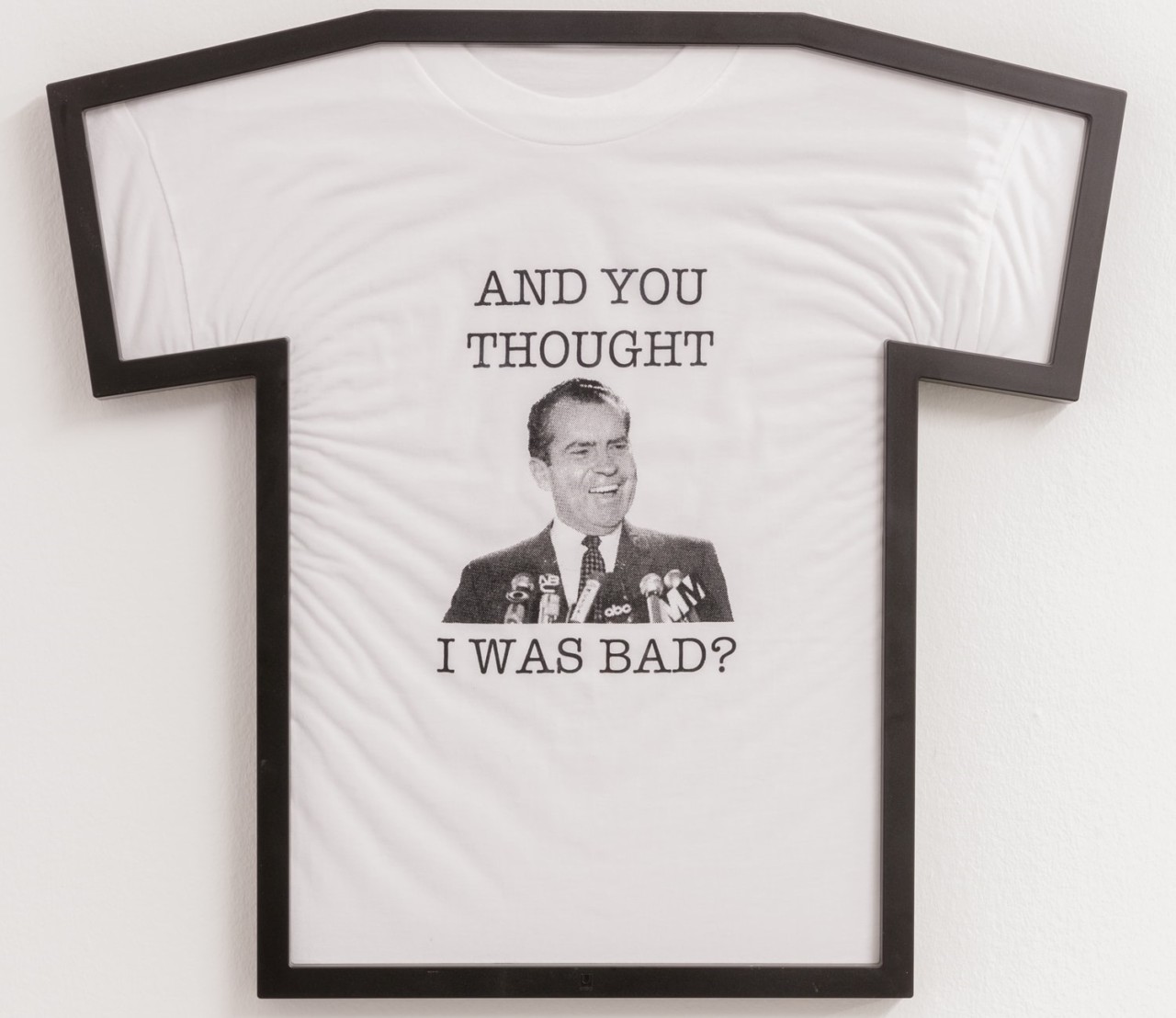


Guy Oliver, And You Thought I Was Bad? (Nixon T-shirt), 2018. Silkscreen on fabric T-shirt, frame. Courtesy the artist and Zabludowicz Collection. Photo Tim Bowditch.
Guy Oliver’s film and installation at the Zabludowicz Collection in Kentish Town is part of a strand of programming there dedicated to showcasing the work of artists who do not have commercial representation in the UK. Oliver graduated from the Painting MA course at the Royal College of Art in 2015 and has since had solo shows in spaces in New York and London. The work on show here centres on the protest t-shirt he dreamed up but failed to make in his early student days. He returns to it now, as suddenly relevant again.
Oliver’s single-screen projection, And You Thought I was Bad, is flanked by three wall-based works, paintings with accumulations of objects now hermetically associated with the 1990s and early 2000s. VHS tapes, for example, just look impossibly dated in 2018, let alone films like Michael Douglas’ Falling Down and references to OJ Simpson. The works set up the territory for the film that locates itself historically in the period when the artist was studying for his BA at the University of East London 2003-2006. It was the era of President George W Bush, and the artist’s outrage at the Iraq War prompted him to look back thirty years to another President who took America to war, and his famous encounter with an artist who seized the opportunity to protest.
In 1972 Johnny Cash was invited to the White House by Richard Nixon. Instead of playing the ultra-conservative Country songs that the President requested, Cash played a track from his album “The Mystery of Life”, called What is Truth. In it the singer calls out the government for sending young American boys to war in Vietnam. Nixon fatally misjudged the Man in Black’s political convictions and the way he aligned himself with the young and the oppressed. Oliver’s work is frank about the likelihood of art being able to change the course of history, but also reflects the irresistible desire of the artist to express their rage.
Throughout the film the artist assumes the persona of a TV presenter, or arts reporter, leading the viewer through a narrative that recounts the story of his idea for the protest t-shirt and his failure to make it. Intermittently the film cuts to a rapid montage of news footage from the era: Saddam Hussein, Michael Jackson, Hurricane Katrina, the capture of Osama Bin Laden, George W sitting awkwardly on a child’s chair in a school classroom, presumably in the moments before his aide informs him of the attack on the Twin Towers. Hindsight, and current politics on both sides of the Atlantic, makes this a particularly queasy experience.
Oliver’s presenting style is deliberately stilted, as he recounts in self-deprecating fashion the laziness that meant he never got around to producing the t-shirt with Nixon’s grinning face under the slogan “And You Thought I was Bad”. And how the moment passed and the idea no longer looked as sharp, as witty and relevant. Until now. The sense of impotence experienced by the student artist is reflected in another anecdote that Oliver recounts in the film. He had the idea to make a film of himself watching planes at London City Airport, chanting “crash, crash, crash” as they safely land – only to discover the American Chris Burden’s 1973 performance 747 in which he cuts a lonely figure, shooting at the aircraft taking off from LAX in Los Angeles.
Although we always aim to bring you the latest news from the front line of contemporary art, it is rare to be offered the opportunity to be topical. Whether you are out marching today, or simply watching with dismay at the unfolding events, here is an instance of art and life coinciding. To quote the American artist Sam Durrant: “If you’re not angry, you’re not paying attention”.
Caroline Douglas
Director
Zabludowicz Collection, 176 Prince of Wales Rd, Belsize Park, London NW5 3PT. Open Thursday - Sunday, 12.00 - 18.00. Exhibition continues until 12 August 2018. www.zabludowiczcollection.com